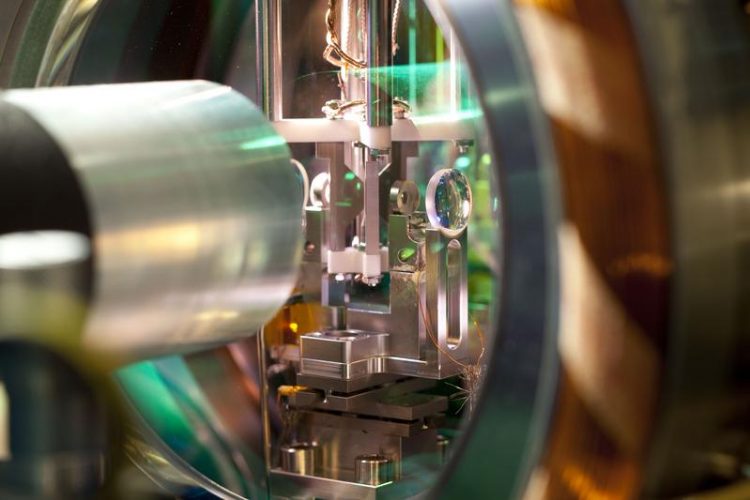Improved interface for a quantum internet

The experimental apparatus in which the researchers demonstrate a quantum interface. Photo: IQOQI/Lackner
Quantum computers are no longer just a theoretical concept. In recent years, researchers have assembled and successfully tested the building blocks for a future quantum computer in the laboratory.
More than a dozen candidate technologies are currently being studied; of these, ion traps are arguably the most advanced. In an ion trap, single atoms can be confined and precisely controlled by means of lasers. This idea was developed by theorists Ignacio Cirac and Peter Zoller, and a team of Innsbruck experimental physicists under Rainer Blatt has been at the forefront of its implementation.
Based at the University of Innsbruck’s Institute for Experimental Physics, the team first demonstrated in 2013 that quantum information stored in a trapped ion can be deterministically mapped onto a photon, that is, a quantum of light. Thus, they were able to construct an interface between quantum processors and optical fiber-based communication channels. Now the physicists have improved this interface, making use of so-called superradiant states.
A reliable interface
“In order to build a quantum network with trapped ions, we need an efficient interface that will allow us to transfer quantum information from ions to photons,” explains Tracy Northup, project leader in Rainer Blatt’s team. “In our interface, we position two ions between two highly reflective mirrors, which form an optical resonator. We entangle the ions with one another and couple both of them to the resonator.”
The collective interaction between the particles and the resonator can now be tuned in order to enhance the creation of single photons. “This is known as a superradiant state,” explains Bernardo Casabone, the article’s first author. In order to demonstrate that the interface is well suited for quantum information processing, the researchers encode a quantum state in the entangled particles and transfer this state onto a single photon.
Because of the superradiant interaction, the photon is generated almost twice as quickly as in their previous experiment. “Thanks to superradiance, the process of information transfer from the particle to the photon essentially becomes more robust,” Casabone emphasizes. As a consequence, the technical requirements for the construction of accurate interfaces may be relaxed.
Read–write capabilities for a quantum memory
In the same experiments on light–matter interactions, the Innsbuck physicists were also able to create so-called subradiant states. Here, the emission of a photon is suppressed rather than enhanced. “These states are also interesting because the stored information becomes invisible to the resonator, and in that sense, it’s protected,” says Northup. As a result, one can imagine that by switching between sub- and superradiant states, quantum information can be stored in ions and retrieved as photons. In a future quantum computer, such addressable read–write operations may be achieved for a quantum register of trapped ions.
The authors are based at the University of Innsbruck and at the Institute for Quantum Optics and Quantum Information of the Austrian Academy of Sciences. Their research was supported by the Austrian Science Funds (FWF), the European Union, and Tirolean industry.
Publication: Enhanced quantum interface with collective ion-cavity coupling. B. Casabone, K. Friebe, B. Brändstatter, K. Schüppert, R. Blatt, and T. E. Northup. Phys. Rev. Lett. 114, 023602
http://dx.doi.org/10.1103/PhysRevLett.114.023602
Physics Synopsis: A Cavity Just for Two
http://physics.aps.org/synopsis-for/10.1103/PhysRevLett.114.023601
For further information, contact:
Tracy Northup
Institut für Experimentalphysik
Universität Innsbruck
Tel.: +43 512 507-52463
E-Mail: tracy.northup@uibk.ac.at
Christian Flatz
Büro für Öffentlichkeitsarbeit
Universität Innsbruck
Tel.: +43 512 507-32022
Mobil: +43 676 872532022
E-Mail: christian.flatz@uibk.ac.at
http://quantumoptics.at – Quantum Optics and Spectroscopy group
http://www.uibk.ac.at/exphys/ – Institut für Experimentalphysik, Universität Innsbruck
Media Contact
All latest news from the category: Physics and Astronomy
This area deals with the fundamental laws and building blocks of nature and how they interact, the properties and the behavior of matter, and research into space and time and their structures.
innovations-report provides in-depth reports and articles on subjects such as astrophysics, laser technologies, nuclear, quantum, particle and solid-state physics, nanotechnologies, planetary research and findings (Mars, Venus) and developments related to the Hubble Telescope.
Newest articles

First-of-its-kind study uses remote sensing to monitor plastic debris in rivers and lakes
Remote sensing creates a cost-effective solution to monitoring plastic pollution. A first-of-its-kind study from researchers at the University of Minnesota Twin Cities shows how remote sensing can help monitor and…

Laser-based artificial neuron mimics nerve cell functions at lightning speed
With a processing speed a billion times faster than nature, chip-based laser neuron could help advance AI tasks such as pattern recognition and sequence prediction. Researchers have developed a laser-based…

Optimising the processing of plastic waste
Just one look in the yellow bin reveals a colourful jumble of different types of plastic. However, the purer and more uniform plastic waste is, the easier it is to…


